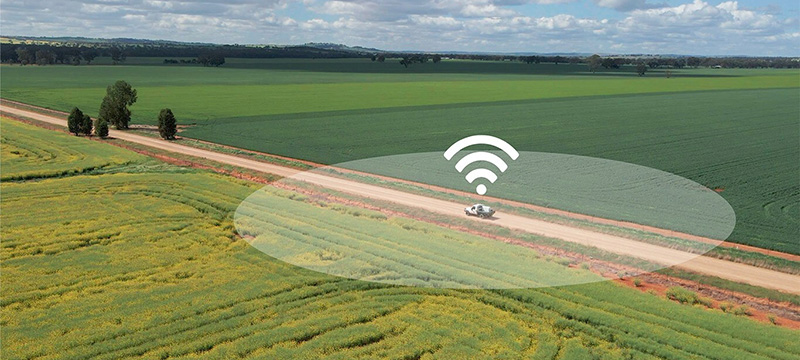Simplified networks, extended ranges and device density all achieved in IoT use cases including Smart Home, Smart City, Industrial IoT, and Agriculture Technology. Industry players now invited to take part in EMEA and APAC phase 3 trials.
The Wireless Broadband Alliance (WBA), the global industry body dedicated to improving Wi-Fi standards and services, has today announced that the successful completion of phase two field trials of IEEE 802.11ah Wi-Fi HaLow, which promises reliable, long-range, low-power connectivity, making it an ideal solution for a variety of IoT scenarios.
Part of the WBA’s Wi-Fi HaLow for IoT project, the trials, which took place in North America, have proven the scalability and efficiency of Wi-Fi HaLow in challenging environments such as dense urban settings and large industrial complexes. The accompanying “Wi-Fi HaLow for IoT: Field Trials Report” details actionable insights for businesses, network planners, and operators.
A range of benefits have been proven in each of the use cases outlined below including extended ranges, improved material penetration capabilities, extended battery life, enhanced device density, a higher level of security, ease of installation and management, and elevated data throughput in IoT scenarios when compared with existing Wi-Fi standards. The phase two field trial use cases were Smart Home, Warehousing, Smart Farm, Smart City, Smart Office Building, Smart School Campus and Smart Industrial Complex.
The trials were conducted by WBA and its members including key partners like Morse Micro, Newracom, and Methods2Business, alongside participants such as AT&T, Charter Communications, Nextcomm Systems, and Qualcomm, which focused on larger-scale implementations and testing Wi-Fi HaLow in more challenging environments.
Setting the standard for simplified mainstream IoT
Wi-Fi HaLow includes a host of key features such as operation in the sub-1 GHz radio band, the use of narrow channel bandwidths, an increased number of supported devices and new operating modes to accommodate battery-operated devices. It also, builds upon the foundations of Wi-Fi, retaining such features as the most up-to-date high levels of security and native-IP support inherent in all internet connectivity.
The “Wi-Fi HaLow for IoT: Field Trials Report” contains actionable insights that can help drive innovation and strategic decisions across the Wi-Fi industry. For businesses, it lays down a roadmap to harnessing Wi-Fi HaLow for developing new products and entering new markets. For network planners and operators, it offers evidence-based strategies for enhancing network capabilities and service offerings. Additionally, the report serves as a valuable educational tool, deepening understanding of Wi-Fi HaLow’s operational dynamics and advantages.
Tiago Rodrigues, CEO of the Wireless Broadband Alliance, said:
“Each of these real-world field trials has been a huge success demonstrating the readiness and the benefits Wi-Fi HaLow standard can bring to a vast range of industries and use cases, improving performance and reducing complexity. We now move to the next phase, and are inviting industry players interested in participating in trials across EMEA and APAC to reach out. Your participation can help shape the future of IoT connectivity and drive innovation across various sectors.”
A summary of each use case and the results
1. Smart Home: In Denver, Colorado, CableLabs’ Kyrio conducted a trial demonstrating Wi-Fi HaLow’s capabilities within a 5,000 sq ft home and across a 3-acre lot, a collaboration involving Methods2Business, Morse Micro, and Newracom. The trial successfully utilized a single access point to deliver robust and secure Wi-Fi coverage throughout the property, eliminating the need for additional repeaters. Over 140 indoor locations were tested, achieving data throughputs exceeding 8 Mbps in high-demand areas and over 2 Mbps in typical usage scenarios. The system efficiently managed 23 simultaneous device connections at MCS7 PHY rates (32 Mbps), and extended its range over 430 meters, showcasing potential for neighbourhood-wide connectivity. Additionally, the trial highlighted efficient network utilization with OTA firmware updates completing in just 30 seconds for a 25 MB file at approximately 20 Mbps, affirming Wi-Fi HaLow’s suitability as a scalable solution for future smart homes and residential networking applications.
2. Warehouse: In a comprehensive trial at a 110,000 sq ft warehouse near Chicago, Wi-Fi HaLow demonstrated its effectiveness in providing robust wireless connectivity across complex industrial environments. The technology achieved extensive coverage with a single access point, delivering varying data rates from 1 Mbps in peripheral zones to 22 Mbps in central areas, thereby supporting a wide range of operational needs from high-definition video streaming to basic sensor communications. The system handled high throughput demands and supported numerous device types seamlessly, proving its versatility and reliability. Notably, Wi-Fi HaLow managed outdoor connectivity up to 1,500 feet with strong signal strength, essential for logistics and fleet management. Redundancy tests further underscored the network’s reliability, with devices swiftly reassociating to alternative access points, ensuring operational continuity. The trial underscored Wi-Fi HaLow’s potential as a scalable, efficient solution for modernizing warehouse operations, highlighting its capability to enhance network performance while reducing infrastructure costs.
3. Smart Farm: In a trial at Scott Farm Market and Greenhouse in Kent, Ohio, teamed up by Newracom and Morse Micro, Wi-Fi HaLow technology demonstrated impressive coverage and performance over a 14-acre agricultural site, addressing challenges such as extensive area coverage and penetration through various structures. The setup included a single Wi-Fi HaLow AP and multiple IoT devices, achieving data rates from 1.3 Mbps at the most challenging points to 22 Mbps near the AP. The technology effectively supported a multi-camera security system, maintaining consistent video streaming across various locations and resolutions, and facilitated robust connectivity for 24 IoT devices simulating typical farm sensors and actuators. The trial underscored Wi-Fi HaLow’s potential to provide reliable, expansive connectivity for smart farming applications with minimal infrastructure.
4. Smart City: In a smart city trial conducted in Irvine, California, Wi-Fi HaLow demonstrated its potential for extensive urban connectivity. Utilizing equipment from Newracom, Morse Micro, and Methods2Business, the technology achieved coverage over a 1 km radius and up to 1.5 miles along Irvine Center Drive. The trial showed strong signal strength capable of supporting high Modulation and Coding Schemes (MCS) with PHY rates up to 3.34 Mbps. Even in areas with lower signal strength, connectivity remained robust, facilitating smart city applications such as safety monitoring and asset tracking across diverse urban landscapes including retail plazas and business parks.
5. Smart Office Building: The Wi-Fi HaLow trial in the Smart Office Building use case at the Newracom Office Park in Irvine, California, demonstrated the technology’s effective deployment for smart building services with minimal infrastructural enhancements. Companies such as Morse Micro and Methods2Business provided crucial hardware like the MM6108-EKH01 access points and station evaluation kits. This setup enabled Wi-Fi HaLow to offer extensive and reliable coverage across multiple floors and diverse building materials, efficiently overcoming challenges like metal thermal energy-blocking films on glass. The trial emphasized Wi-Fi HaLow’s utility in supporting a variety of services, including HVAC, energy management, and security systems, with significant signal penetration and adaptable coverage. Different bandwidth tests also showcased the system’s flexibility to meet varying operational demands, affirming Wi-Fi HaLow as an ideal solution for contemporary smart building ecosystems within the Newracom Office Park.
6. Smart School Campus: In a trial at Red Hill Lutheran School, companies Newracom, Morse Micro, and Methods2Business demonstrated the efficacy of Wi-Fi HaLow, achieving exceptional network performance across a 5-acre campus encompassing multiple buildings. Despite challenges from thick concrete walls and audio equipment interference, Wi-Fi HaLow provided extensive indoor and outdoor coverage, managed interference without adjacent channel disruptions, and supported the potential to scale up to 32,764 IoT devices efficiently. These results underline Wi-Fi HaLow’s capabilities as a cost-effective and robust network solution for educational settings, highlighting its advantages over traditional Wi-Fi systems with fewer infrastructural demands.
7. Smart Industrial Complex: The Wi-Fi HaLow deployment trial at a large industrial complex in Tampa, Florida, showcased robust and extensive wireless coverage across both indoor and outdoor environments, overcoming the challenges posed by heavy machinery and metal structures. The trial, conducted by Morse Micro, Nexcomm Systems, and Newracom, achieved high data throughput rates, with UDP traffic peaking at 21.3 Mbps and reliable connectivity extending up to 425 feet in high-density areas. This demonstration highlighted Wi-Fi HaLow’s capability to support critical industrial applications such as real-time asset tracking and extensive video surveillance, proving its effectiveness in complex RF environments typical of large-scale industrial settings.
Marleen Boonen, CEO & Founder of Methods2Business, said: “After several years of intense collaboration with the other Wi-Fi HaLow device manufacturers to establish in 2021 the Wi-Fi CERTIFIED® HaLow standard, it’s really great to further strengthen our joint efforts in the Wireless Broadband Alliance to jointly develop the global Wi-Fi HaLow market. Our company is really delighted about the overwhelming range, coverage and penetration results obtained in the US field trials with the different vendor solutions in various real-life use cases. After this great experience, our team is very motivated to demonstrate more benefits of the Wi-Fi HaLow technology, like lower power consumption for a multi-year battery operation in sensors, in the upcoming field trials in Europe and Japan.”
Michael De Nil, co-founder and CEO of Morse Micro, said: “We’re delighted to have contributed to the ‘Wi-Fi HaLow for IoT: Field Trials Report,’ highlighting Wi-Fi HaLow’s potential to transform the IoT landscape. With its extensive range, superior penetration, and enhanced battery life, Wi-Fi HaLow is poised to revolutionize various industries, including agriculture, smart cities, and manufacturing, improving efficiency and data collection but also broadening operational possibilities. As Wi-Fi HaLow transitions into practical applications, we are excited to showcase its advantages and helping industries worldwide adopt this groundbreaking technology.”
Zac Freeman, Vice President of Marketing & Sales of Newracom, added: “Wi-Fi HaLow’s shines across a wide range of industries as a preferred connectivity technology, with its long-range, signal penetration, and data throughput. From open fields to industrial factories, Wi-Fi HaLow provides reliable fast connectivity with simple architecture that can’t be replicated by any other technology, ticking all the boxes for requirements for IoT deployments. We could not be more pleased with our involvement and results of the WBA “Wi-Fi HaLow IoT Field Trials Report”, confirming Wi-Fi HaLow’s capabilities in rigorous real-world environments, from homes to warehouses, farms to factories, to consistently deliver the next generation of IoT devices.”
The post Wireless Broadband Alliance Announces Triumphant Wi-Fi HaLow Phase Two Real-World IoT Field Trials appeared first on IoT Business News.

































